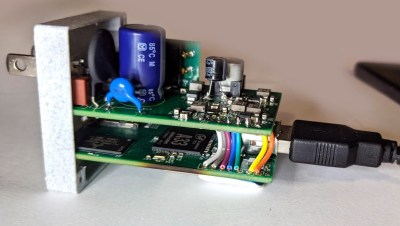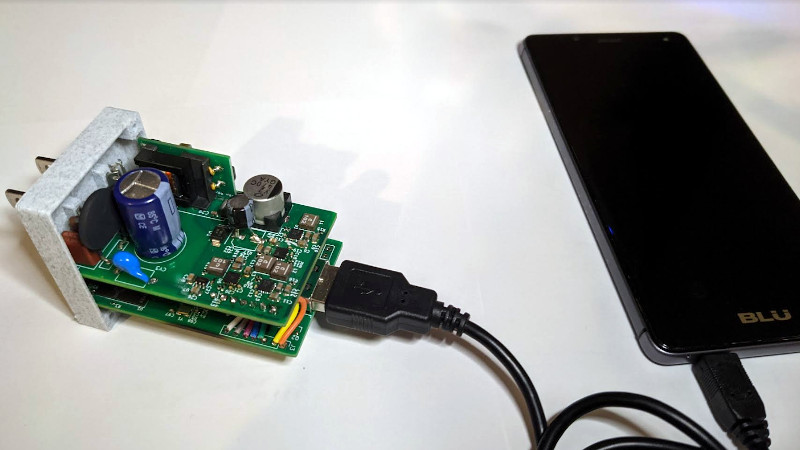There was a time, not quite so long ago, when a computer was a beige box that sat on your desk. Before that, computers were big enough to double as desks, and even farther back, they took up a whole room. Today? Well today it’s complicated. Single-board computers (SBCs) like the Raspberry Pi put a full desktop experience in the palm of your hand, for a price that would have been unfathomable before the smartphone revolution increased demand for high-performance ARM chips.
But compared to the tiny open hardware Linux SBC that lives inside the WiFiWart, even the Raspberry Pi looks massive. Developed by [Walker] as a penetration testing tool, the custom computer is housed in an enclosure designed to make it look like a traditional (if a bit large) USB phone charger. In fact, it doesn’t just look like a USB charger, it actually is one. The internal power supply is not only capable of converting AC into the various DC voltages required to run the miniature Linux box, but also features a USB port where you can plug in your phone to charge it.
 For the infosec folks in the audience, the applications for the WiFiWart are obvious. Just plug this thing in somewhere inconspicuous, and you’ve got a foot in the door. The dual WiFi interfaces mean you can connect to a target network on one card and use the second to spin up a fake access point or exfiltrate data. Plus with a quad-core Cortex-A7 ARM processor running at 1.2 GHz and a healthy 1 GB of DDR3, you’ll have enough power to run many security tools locally.
For the infosec folks in the audience, the applications for the WiFiWart are obvious. Just plug this thing in somewhere inconspicuous, and you’ve got a foot in the door. The dual WiFi interfaces mean you can connect to a target network on one card and use the second to spin up a fake access point or exfiltrate data. Plus with a quad-core Cortex-A7 ARM processor running at 1.2 GHz and a healthy 1 GB of DDR3, you’ll have enough power to run many security tools locally.
But of course, nothing keeps you from using the WiFiWart for non-security purposes. That’s what has us particularly excited, as you can never have enough open hardware Linux boards. Especially ones this tiny. Removed from its wall charger disguise, the brains of the WiFiWart could be used for all kinds of projects. Plus, not only is the final design open source, but [Walker] made sure to only use free and open source tools to create it. Keeping his entire workflow open means it will be easier for the community to utilize and improve upon his initial design, which in the end, is the whole idea behind the open hardware movement and efforts such as the Hackaday Prize.

















Is it me, or does the lower board appear to have been overheated / burned, right in the middle?
Maybe it was laser cut and something made it linger a bit too long there?
Looks like we need a heatsink. I bet it gets toasty in there.
Could have overheated during DIY reflow.
That was damage from when I was using a heatgun, not from operation :)
Lay aluminum foil where you dont want the heat. Also, use it to make a shaped nozzle for the gun. Use windings of unclad single strand copper wire to pinch the nozzle onto the smooth heat gun nose.
But can it be used to mesh network a house with poor wifi coverage?😏
Sounds like it will if you install the right software. I may be wrong, but I wouldn’t expect stellar coverage or wall penetration. Install enough of them and that won’t be a problem.
Could always put external antenna plugs on it and then put holes in the case and put external high gain antennas on it
heh i did 3d print a 120V light switch cover for where i needed an odd dimension…but still, seeing someone else mix FDM plastic and 120V in such a tight container makes me nervous :)
You could always fit a “zero” sized board into a multiplug mains adapter.
It looks too lopsided to remain plugged into a wall outlet.
At the design the actual dimensions.
If the longer side runs down it should hold ok. If you put it long side up, it may flop down.
“The dual WiFi interfaces mean you can connect to a target network on one card and use the second to spin up a fake access point or exfiltrate data.”
I don’t get the point, if you are able to connect to the target wifi in first place, you don’t need this at all…
On the other side, the same hardware plugged on a POE ethernet port is probably much more useful for pentest…
Being able to connect to the wifi doesn’t guarantee you’ll be able to intercept packets, spoofing an access point does guarantee packets (if you can convince your targets to connect to you). You’re asking “why have a knife when you’ve already got a spoon?” the spoon’s fine if your meal is already cut, but if it’s not cut you’ll wish you had a knife.
Think Mr. Robot style, you go in the building as a cleaner and plant this devices somewhere. By connecting to the wifi inside the building it can create a remote access tunnel back to a server you control. So from that point on you have access to the device and do your devious things.
I would never assume the Intranet in an office is connected to the Internet. If you want to “hack” like this, you should have a 4G modem incorporated. WiFi to the office net, 4G as the “backdoor”. Even IF the Intranet is connected to Internet, it might not allow outgoing connections unless you use Proxy or VPN.
I agree…not mainly because this could become a very good low power wall wart router, or even a remote AP if needed if it had POE and/or an ethernet jack, running OpenWRT or whatnot on it. Definitely the beginnings of a great project that can get people away from proprietary routers and their weaknesses.
No mention of cost. Is it a kit or just a design you can adapt as you build it? As an access point of expansion it is probably not cost effective without some mods. As a core for a project it can be OK depending on needs but there are so many curent choices I dont see much need for yet another SBC.